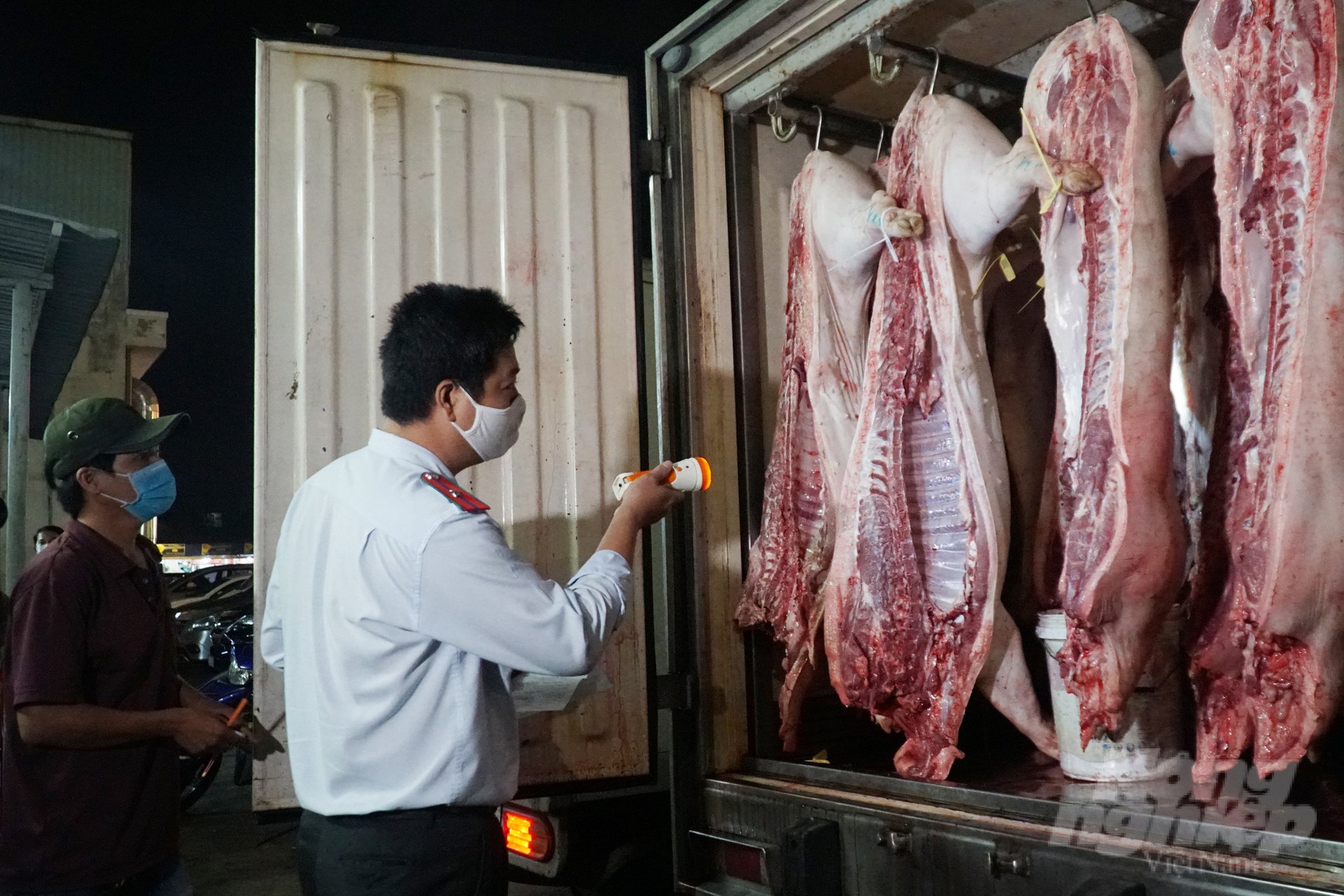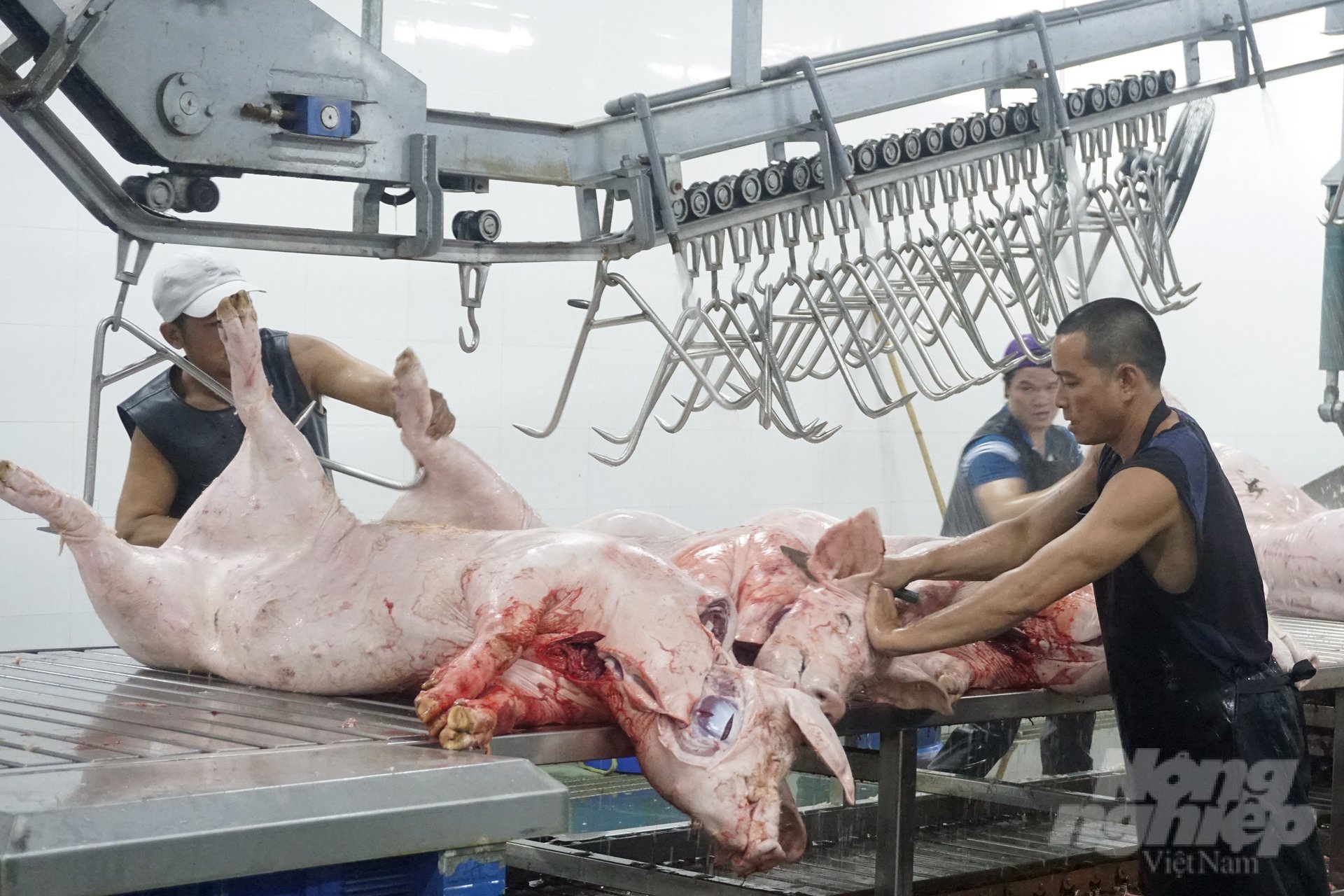November 28, 2025 | 02:27 GMT +7
November 28, 2025 | 02:27 GMT +7
Hotline: 0913.378.918
November 28, 2025 | 02:27 GMT +7
Hotline: 0913.378.918

Functional forces control pork before being sold at Binh Dien wholesale market. Photo: Nguyen Thuy.
From April 1, 2023, Ho Chi Minh City switched to industrial slaughtering and stopped manual slaughtering activities.
In Ho Chi Minh City, there are five concentrated, industrial-oriented cattle slaughtering factories in Cu Chi, Hoc Mon, and Binh Thanh districts.
The average total slaughter volume is 5,200 - 6,000 heads/day, accounting for about 60% of the total pork supply in the city market. 40% of the remaining pork volume is brought from the provinces to Ho Chi Minh City for consumption.
However, according to reflection, manually slaughtered pork from neighboring provinces is still brought to Ho Chi Minh City for consumption, affecting industrial slaughterhouses in Ho Chi Minh City.
Before this problem, Deputy Director of the Department of Agriculture and Rural Development of Ho Chi Minh City Nguyen Xuan Hoang said to ensure the interests of industrial slaughterhouses according to the policy of the People's Committee of Ho Chi Minh City, the Department has implemented many solutions.
Specifically, the Department coordinated with the Food Safety Management Board of Ho Chi Minh City to advise the People's Committee of Ho Chi Minh City to promulgate and implement synchronously and drastically the 4 Plans:
Plan for communication to bring cattle and poultry slaughtering into industrial-scale production;
Plan for management, market control, circulation, transportation, and trading of livestock and poultry meat;
Plan to increase cattle slaughter capacity at industrial slaughterhouses;
Plan to inspect the manual cattle slaughtering activities after the extension of the cattle and poultry slaughtering facilities expires.
Simultaneously, the HCMC Department of Agriculture and Rural Development will coordinate with District People's Committees to exchange, facilitate and connect traders at manual cattle slaughtering establishments to slaughter at industrial cattle slaughterhouses.
Also, mobilize, guide, and support industrial cattle slaughter plant investors to participate in city programs such as safe food chain, price stabilization, traceability, Ho Chi Minh City Agricultural Gold brand... to provide a safe food source for city consumers.
In addition, the Sub-Department of Livestock Production and Animal Health of Ho Chi Minh City cooperates with functional sectors such as the Food Safety Management Board, the Market Management Department, and district and inter-sectoral delegations to strengthen inspection and supervision. Monitor animal products from the provinces brought to the city for consumption at wholesale and traditional markets.

Ho Chi Minh City is the first locality to remove of manual slaughterhouses, switching to industrial slaughter. Photo: Nguyen Thuy.
The Ho Chi Minh City Department of Animal Husbandry and Animal Health coordinated with the city's interdisciplinary inspection teams to prevent and control livestock and poultry diseases (groups 1, 2, and 3) to strengthen inspection and supervision at the gateway to the city to detect and strictly handle the means of transporting animals and animal products from the provinces in contravention of regulations.
Coordinate with district and inter-sectoral delegations to strengthen inspection, blocking, monitoring, and strictly handling violations in illegal animal transportation, trading, and slaughtering in the area, especially areas bordering provinces and regions having manual cattle slaughtering establishments after the extension of the operation period expired under Decision No.231/QD-UBND.
Coordinate with departments, agencies, and district People's Committees to strengthen supervision and inspection of microbiological indicators, antibiotic residues, and banned substances of beta-agonist groups to ensure the safety of the source of animal products supplied to the market in the city, especially the source of slaughtered animal products from the provinces brought to Ho Chi Minh City for consumption, exchange, and information supply for the provinces to correct for cases with unsatisfactory monitoring results according to regulations.
According to Mr. Dinh Minh Hiep, Director of Ho Chi Minh City Department of Agriculture and Rural Development, when implementing the policy of stopping manual slaughter and switching to industrial slaughterhouses, the Department will strictly manage and limit the source of slaughtered meat from the provinces.
In addition, the Department has also submitted to the People's Committee of Ho Chi Minh City and the Ministry of Agriculture and Rural Development on the criteria that must be met to bring pork to Ho Chi Minh City for consumption. These criteria are equivalent to the slaughter requirements according to industrial slaughter standards. Thus, manual slaughter will not meet the criteria when bringing meat to the wholesale markets in Ho Chi Minh City for consumption, which means that traders move to manual slaughterhouses in the provinces, then transport Moving meat back to Ho Chi Minh City for consumption will face difficulties after the criteria are approved and implemented.
Translated by Ha Phuc

(VAN) China’s cooking oil is suddenly flooding into India. It all comes down to a soybean surplus that Beijing doesn’t quite know what to do with.

(VAN) An Giang promotes supply-demand connections, standardizes quality and builds value chains, creating a foundation for sustainable bird’s nest development and aiming to expand exports.
/2025/11/24/5339-4-nongnghiep-075331.jpg)
(VAN) Recently, the conference on 'Sustainable Fisheries Linkage Chain - Tilapia for Export' took place in Tien Hai commune, Hung Yen province.
/2025/11/21/4309-2-153400_128.jpg)
(VAN) Green and low-emission rice is paving the way for Vietnamese rice to enter high-end markets, marking the beginning of a transformation journey toward greening and elevating the national rice brand.

(VAN) ‘Right to Win’ outlines a national action plan that shapes a new vision for Viet Nam’s agriculture in an era of renewal and global integration.

(VAN) Lam Dong’s farmed sturgeon output this year is expected to reach 2,300 tons, worth VND 450 billion, affirming the brand’s position on the market.

(VAN) A surge in Ukrainian egg exports, largely driven by soaring sales to the UK over the last few years, has notably pushed up egg prices on the domestic market.